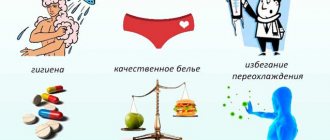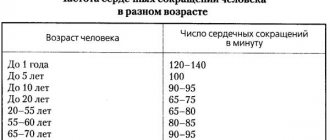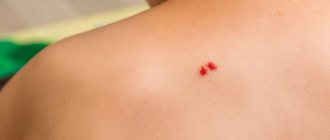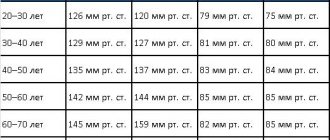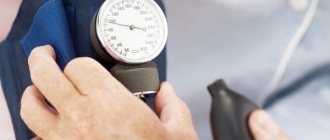A high pulse with normal blood pressure is not such a rare phenomenon, requiring attention from a general practitioner and cardiologist. If the pulse pressure increases, this fact is rarely noted by the person himself before recording the indicators; usually this condition is manifested by changes in well-being, which is the reason for contacting a specialist. Often, the pulse frequency changes after physical exertion, stress and as a result of fatigue, and this symptom is accompanied by an increase in blood pressure (BP).
But this does not mean that the heart rate cannot increase without an increase in systolic pressure; it can jump even with normal tonometer readings. Today we need to figure out what a high heart rate at the same time as normal blood pressure indicates, what causes the condition, and how to deal with it.
Heart rate indicators
The pulse is characterized by several values.
Frequency – number of beats per minute. It must be measured correctly. The pulse in a sitting position and in a lying position may differ. Therefore, use the same posture when taking measurements, otherwise the data obtained may be misinterpreted. Also, the frequency increases in the evening. Therefore, do not be alarmed if its value is 75 in the morning and 85 in the evening - this is normal.
Important! The pulse is measured for 60 seconds. Not 30, but then multiplied by 2, namely 60! Because if there is an arrhythmia, then a minute is exactly the period in which it will certainly manifest itself.
Rhythm - if the time interval between adjacent beats is different, then arrhythmia is present.
Filling - characterizes the difficulty of detecting the pulse, depends on the volume of blood distilled by the heart at one time. If it is difficult to palpate, this indicates heart failure.
Voltage – characterized by the effort that must be applied to feel the pulse. Depends on blood pressure.
Height - characterized by the amplitude of vibration of the arterial walls, a rather complex medical term. It is important not to confuse heart rate and heart rate; these are completely different concepts. The cause of a high pulse (not rapid, but high!) in most cases is improper functioning of the aortic valve.
What can you do
The principles of treatment of sinus tachycardia are determined, first of all, by the causes of its occurrence. Treatment should be carried out by a cardiologist together with other specialists.
It is necessary to eliminate factors that contribute to an increase in heart rate: eliminate caffeine-containing drinks (tea, coffee), nicotine, alcohol, spicy foods, chocolate; protect yourself from psycho-emotional and physical overload. Physiological sinus tachycardia does not require treatment.
Treatment of pathological tachycardia should be aimed at eliminating the underlying disease. In case of extracardiac sinus tachycardia of a neurogenic nature, the patient needs to consult a neurologist. Treatment uses psychotherapy and sedatives (luminal, tranquilizers and antipsychotics: tranquilan, relanium, seduxen).
In the case of reflex tachycardia (with hypovolemia) and compensatory tachycardia (with anemia, hyperthyroidism), it is necessary to eliminate the causes that caused them. Otherwise, therapy aimed at reducing heart rate can lead to a sharp decrease in blood pressure and aggravate hemodynamic disorders.
For sinus tachycardia caused by thyrotoxicosis, β-blockers are used in addition to thyreostatic drugs prescribed by the endocrinologist. Preference is given to β-blockers of the oxyprenolol, practolol and prindolol group. If there are contraindications to β-blockers, alternative medications are used - non-hydropyridine calcium antagonists (verapamil, diltiazem).
For sinus tachycardia caused by heart failure, cardiac glycosides (digoxin) are prescribed in combination with beta-blockers.
Increased heart rate: causes
The first and main reason, as is the case with many other diseases, is a sedentary lifestyle. The second is a weak heart muscle, which is unable to maintain normal blood circulation even with mild physical exertion.
In some cases, a rapid heart rate may be normal. This happens in old age and during the first years of life. Thus, in newborn babies, the heart rate is 120-150 beats per minute, which is not a deviation, but is associated with rapid growth.
Often, a rapid pulse is a symptom of tachycardia if it manifests itself in a calm state of the human body.
Tachycardia can result from:
- Fever;
- Improper functioning of the nervous system;
- Endocrine system disorders;
- Poisoning the body with toxins or alcohol;
- Stress, nervousness;
- Oncological diseases;
- Cachexia;
- Anemia;
- Myocardial lesions;
- Infectious diseases.
Antidepressants should be used with caution. An incorrectly selected drug can cause a rapid pulse
Factors that can cause rapid heart rate:
- Insomnia or nightmares;
- Use of drugs and aphrodisiacs;
- Use of antidepressants;
- Use of drugs that stimulate sexual activity;
- Constant stress;
- Alcohol abuse;
- Overwork;
- Excess weight;
- High blood pressure;
- Cold, ARVI or flu.
Diagnosis of tachycardia
The leading role in the differential diagnosis of the type of tachycardia, determination of rhythm and heart rate belongs to electrocardiography (ECG). When arrhythmia paroxysms occur, daily Holter ECG monitoring is highly informative. This method allows you to identify and analyze any disturbance of heart rhythm during the day, as well as determine ischemic ECG changes during the patient’s normal physical activity.
A routine research method to exclude heart pathology in case of any rhythm disturbances is echocardiography, which provides information on the size of the heart chambers, the thickness of the myocardial walls, disturbances of local contractility and pathology of the valve apparatus. In rare cases, magnetic resonance imaging of the heart is performed to identify congenital pathology.
Invasive methods for examining patients with tachycardia include electrophysiological studies. The method is used in the presence of appropriate indications before surgical treatment of arrhythmia only to a limited number of patients. Using an electrophysiological study, the doctor obtains information about the nature of the propagation of the electrical impulse throughout the myocardium and determines the mechanisms of tachycardia or conduction disorders.
To identify the cause of tachycardia, additional research methods are sometimes prescribed: a general blood test, a blood test for thyroid hormones, electroencephalography, etc.
When can a rapid heart rate be considered normal?
There are several conditions of the body when a high heart rate may not be an alarming signal, but a normal phenomenon:
- Age - as you get older, the frequency decreases, but in children it can be 90-120 beats per minute;
- Physical development - people whose bodies are trained have a higher heart rate compared to those who lead a less active lifestyle;
- Late pregnancy.
High temperature and heart rate are also directly related. It has been experimentally revealed that with an increase in body temperature by 1 degree, the pulse becomes faster by 10 beats per minute.
Tachycardia
When identifying the causes of a rapid pulse, one cannot help but talk in detail about tachycardia. Rapid pulse is one of its main symptoms. But tachycardia itself does not arise out of the blue; you need to look for the disease that caused it. There are two large groups of these:
- Cardiovascular diseases;
- Diseases of the endocrine system and hormonal disorders.
Whatever the cause of tachycardia, it must be identified and treated immediately. Currently, unfortunately, cases of paroxysmal tachycardia, which is accompanied by:
- Dizziness;
- Acute pain in the chest in the region of the heart;
- Fainting;
- Shortness of breath.
Tachycardia interferes with normal heart function
The main group of people susceptible to this disease are alcoholics, heavy smokers, people who have been taking drugs or strong medications for a long time.
There is a separate type of tachycardia that healthy people can suffer from, it is called neurogenic, and is associated with disorders of the peripheral and central nervous systems, which leads to a deterioration in the function of the conduction system of the heart, and, as a result, a rapid pulse.
Symptoms
The presence of clinical symptoms of sinus tachycardia depends on the degree of its severity, duration, and the nature of the underlying disease.
With sinus tachycardia, subjective symptoms may be absent or minor: palpitations, discomfort, a feeling of heaviness or pain in the heart area.
Inappropriate sinus tachycardia can be manifested by persistent palpitations, a feeling of shortness of breath, shortness of breath, weakness, and frequent dizziness. Fatigue, insomnia, decreased appetite, decreased performance, and worsened mood may occur.
The degree of subjective symptoms is dictated by the underlying disease and the sensitivity threshold of the nervous system. In case of heart disease (for example, coronary atherosclerosis), an increase in the number of heart contractions can cause attacks of angina pectoris, worsening the symptoms of heart failure.
With sinus tachycardia, there is a gradual onset and end. In the case of severe tachycardia, symptoms may reflect disturbances in the blood supply to various organs and tissues due to a decrease in cardiac output. Dizziness and sometimes fainting appear; with damage to cerebral vessels - focal neurological disorders, convulsions. With prolonged tachycardia, there is a decrease in blood pressure (arterial hypotension), a decrease in diuresis, and coldness of the extremities is observed.
Increased heart rate with normal blood pressure
If your blood pressure is not alarming, but your pulse is going through the roof, this is an alarming signal and a good reason to visit a doctor. In this case, the doctor will order an examination to identify the cause of the rapid heartbeat. As a rule, the cause is thyroid disease or hormonal imbalance.
An attack of rapid heart rate with normal blood pressure can be eliminated by doing the following:
- Cough;
- Pinch yourself;
- Blow your nose;
- Wash with ice water.
Diagnostics
Measures to eliminate the increase in heart rate should be taken immediately when symptoms are detected. Before prescribing treatment, the doctor will conduct a detailed examination, collect anamnesis, and find out whether any of the patient’s family members suffered from cardiovascular pathologies. To determine why the pulse fluctuates despite normal blood pressure readings, a comprehensive diagnosis is needed.
The recommended list of examinations includes:
- general blood tests and for biochemical composition - here signs of chronic inflammation in the body, lack of hemoglobin and other problems may appear;
- ECG – to assess the functioning of the heart;
- taking blood for analysis of hormone levels - allows you to identify incipient diseases of the endocrine system;
- daily monitoring of blood pressure and heart rate to record the time of increase in pulse and the conditions predisposing to it;
- Ultrasound of the heart;
- Ultrasound of the abdominal organs, liver, kidneys.
Performing an ultrasound of the heart
If consultation with additional specialists is required, the patient is referred to a neurologist, endocrinologist, or ENT doctor, depending on the root cause of the signs of arrhythmia.
Treatment for palpitations
If the heartbeat is frequent due to high temperature, then antipyretic drugs and methods will help.
If your heart is ready to jump out of your chest due to excessive physical exertion, you should stop and rest a little.
During an attack of tachycardia, it is recommended to drink a glass of clean cold water in small sips, holding your breath. This simple technique helps normalize your heart rate.
Acupressure in the neck area is a very effective remedy. But it should be done by an experienced person, massaging the area of pulsation of the carotid artery from right to left. By breaking the sequence, you can make a person faint.
Acupressure of the neck is effective during an attack of tachycardia, but must be performed by a professional
There are medications that help reduce heart rate:
- Corvalol;
- •Vaocordin;
- Hawthorn tincture.
First aid for increased heart rate
If your heart rate is very high, do not panic. You can try home remedies to relieve the condition before you start taking medications. You need to take a horizontal position, raise your legs so that they are above the level of your head and lie down for 10–15 minutes. In this case, it is recommended to open the windows to provide oxygen access, and then take a deep breath and cough as you exhale.
If the condition has not stabilized on its own, and your health is worsening, you should call a medical team, and before they arrive, perform a number of actions:
- drink tincture of peony, motherwort, valerian or dissolve a Validol tablet;
- With little effort, press your eyeballs with your eyes closed and hold this position for 20–30 seconds;
- induce vomiting; impact on the root of the tongue;
- Gently massage the sides of the neck, at the location of the carotid arteries.
You can take a 20 mg tablet of Anaprilin, but other drugs are not allowed to be used without the permission of doctors. If, as a result of an increase in heart rate, a person loses consciousness, he needs to be washed with cold water, unbuttoned his clothes to allow fresh air to enter, and brought to his senses with ammonia.
Folk remedies to combat rapid heart rate
- Pour 1 teaspoon of celandine and 10 grams of dried hawthorn into a glass of boiling water, leave well.
- Mix 1 share of chokeberry juice, 3 shares of cranberry juice, 2 shares of carrot juice and 2 shares of alcohol. Squeeze 1 lemon into the mixture.
- A mixture of lemon and honey is incredibly effective. You need to take 1 kg of lemons, 1 kg of honey, 40 apricot kernels. Grate the lemons, peel the seeds and crush them. Mix everything with honey.
A rapid heart rate can be the cause of many diseases. Timely detection of the disease is the key to its successful treatment!

